What Are the Best Mulches for Raised Beds? 5 Great Options
-
- Last updated:
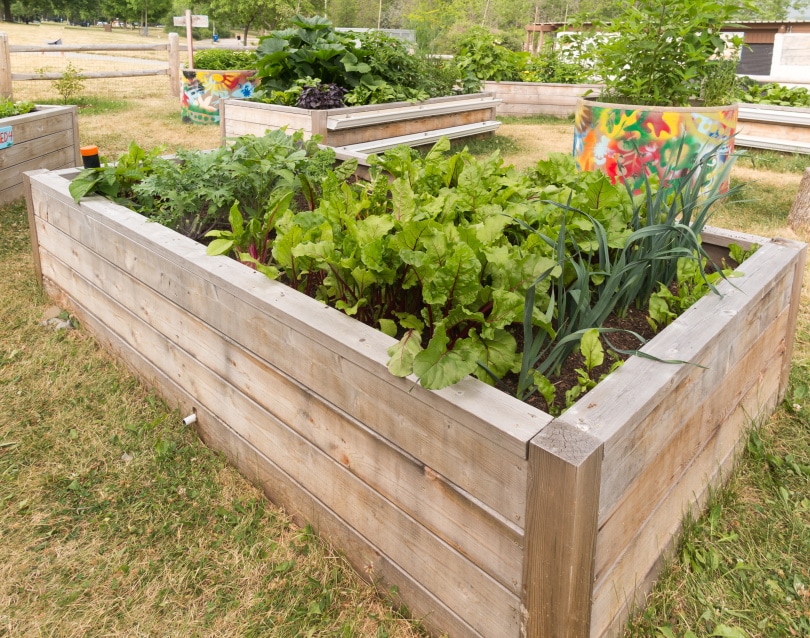
Raised gardens give us convenience and productivity that a traditional bed can’t always match, but they’re still susceptible to the typical gardening woes. Weeds can easily sneak in, and poor soil quality will give you underwhelming results no matter where you plant.
After putting in the effort to build your beds, your work shouldn’t go to waste because you forget everyday gardening details.
Common problems require similar solutions. From landscaping features to a raised garden, mulch can be your best friend almost anywhere, doing the dirty work of suppressing weeds, regulating the soil temperature, and managing moisture. We’ll show you how to keep your plants thriving with this look at the best mulches for raised beds.

The 5 Best Mulches for Raised Beds
1. Grass Clippings

Using grass clippings is one of the most convenient mulching options for raised beds. You’re already creating the mulch every time you mow the lawn, so repurposing the clippings for the garden is a free and effortless way to feed and protect your plants. Grass clippings add a healthy amount of nitrogen and potassium to the soil while providing the typical mulch duties of keeping down weeds and retaining moisture.
A bagged mower is an enormous help if you want to use grass clippings. But you can also use a less expensive lawn sweeper, like the Earthwise 21-inch sweeper, to efficiently collect mulched grass and leaves after mowing.
Using Grass Clippings
You shouldn’t use chemical pesticides or fertilizers in your grass that could contaminate the raised bed. Likewise, any weeds or seed heads in the mix will undoubtedly bring some unwanted growth.
Grass clippings demand extra preparation before going into the garden. You’ll typically have to spread your clippings out to let them air dry for 1–2 days. Wet grass can form slimy, smelly mats that will restrict oxygen and moisture from reaching the soil, ultimately doing more harm than good.
Fortunately, the hard work of drying clippings pays off over the long term. Clippings are stored easily in bags and barrels or under tarps, providing a usable supply for 1–2 years. They also make a perfect addition to composts alongside popular carbon-rich mulches like newspaper and straw.
- Free to collect
- Easy to store, keeps for up to two years
- Breaks down quickly, it excellent compost addition
- Adds nitrogen, potassium, and other nutrients to the soil
- Clippings need time to dry
- Could contain weed seeds and chemicals
2. Newspaper and Cardboard
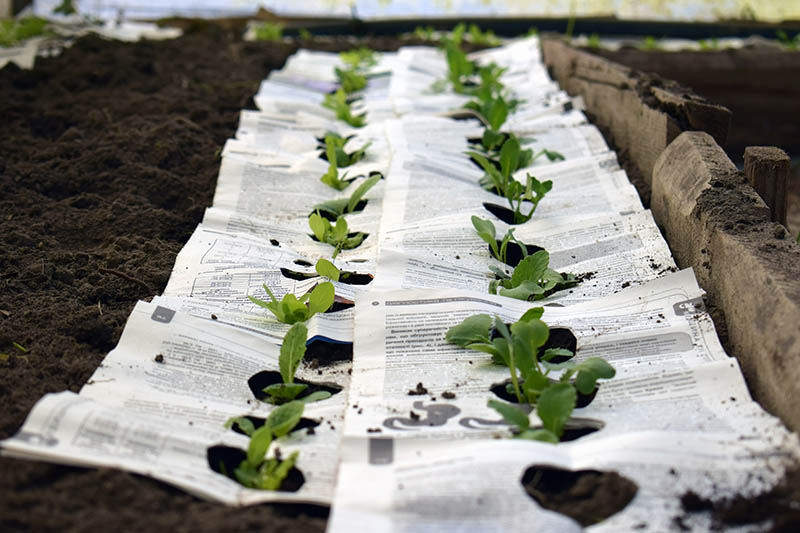
Mulching is the most eco-friendly way to dispose of old newspapers and cardboard. While they aren’t as attractive as some other mulches, they make an ideal base layer to insulate the soil and keep weeds away. Often lasting for the entire season, paper and cardboard mulches work equally well for annuals and perennials.
Using Paper Mulches
Cardboard and newspaper are excellent weed suppressors and add carbon to fuel the microbes in the soil. But assessing the condition is critical before you toss the recycling over your raised garden bed.
Glossy and waxy coatings and packaging tape residue on product packaging create impermeable layers that will prevent gas exchange and hamper microbe growth in the soil. Use only untreated papers, or purchase a specialty paper product like DeWitt’s Natural Garden Barrier. The 300-foot roll of biodegradable paper supplies exceptional weed suppression without sacrificing airflow.
Paper mulch, whether newspaper or cardboard, can lift from the slightest breeze, so wetting it before the application can make life much easier. Improve the look and keep it in place by adding another mulch on top, such as grass clippings or straw. You can work any remaining paper into the soil at the end of the growing season.
- Eco-friendly recycling alternative
- Inexpensive and accessible
- No risk of adding unwanted seeds or weeds
- Needs an additional mulch layer to hold it in place
- Paper products can attract unwanted pests like slugs and termites
- May have coatings that hinder moisture absorption and breakdown
3. Straw
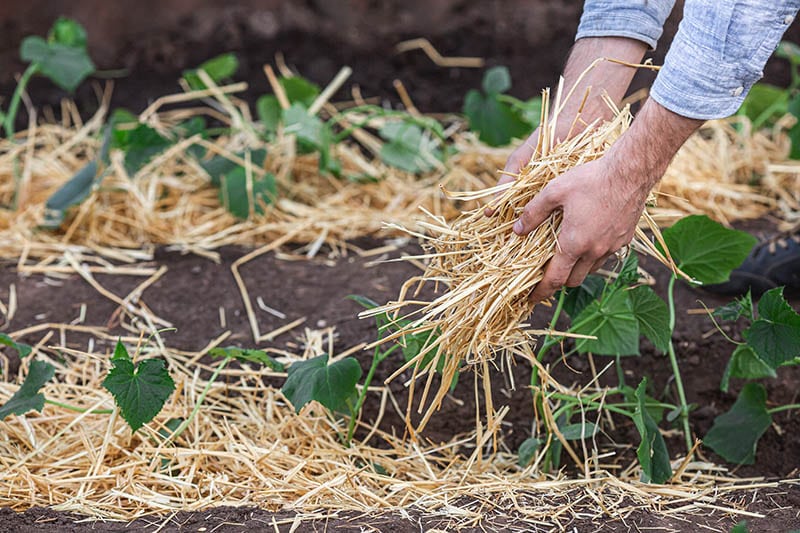
Straw is permeable, offering excellent moisture retention without the excessive seediness of hay. While it can still store some seeds, commercial varieties like EZ Straw are up to 99% weed-free. Although wheat straw is the most readily available type, rice straw is the least likely to contain seeds and introduce undesirable plants to the raised bed.
Using Straw Mulch
As another carbon-rich mulch, straw will introduce essential nutrients to the soil as it degrades. Soil quality and texture will improve, and watering needs can drop substantially. Like grass clippings, straw must be free of pesticides, moisture, and excessive seeds to provide the most benefit, making proper sourcing and preparation essential priorities.
Add a two-inch layer of straw around your raised garden plants, leaving it through the winter as desired to maintain the soil structure and temperature. As spring arrives, you can either recycle the old straw into the compost heap or keep whatever remains and top it off.
- Resists matting to maintain moisture and airflow
- Can be aesthetically pleasing
- Often contains seeds
- Can be expensive
- Presents potential fire risk
4. Pine Straw
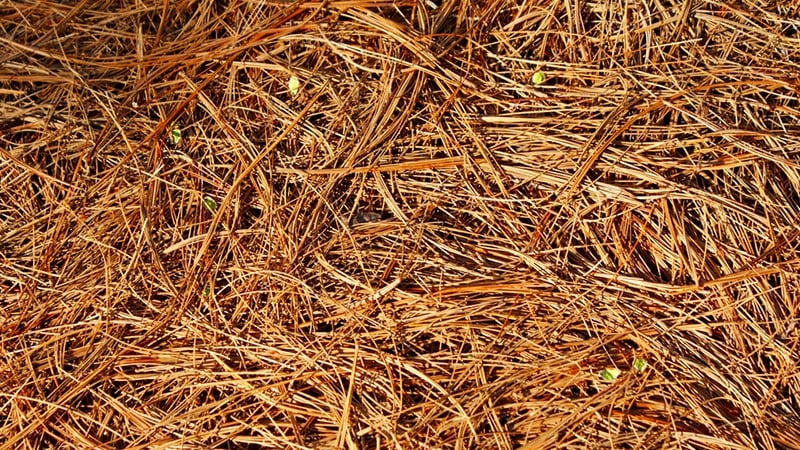
Depending on your surroundings, pine straw might be the cheapest and most accessible mulch for your raised garden beds. Pine straw is also available online from popular suppliers like USA Pinestraw, and while it’s more expensive than other mulches, you’ll benefit from its extended longevity.
Using Pine Straw
Pine straw is lightweight and workable, making it easy to shape into a mat in your raised bed. Although they don’t provide the best weed prevention, the interlocking needles offer excellent insulation and moisture retention for the soil. It can sometimes hold moisture too well, allowing for potential rot and pest problems.
The longer the needles, the better they will interlock and stay in place. The layering should be relatively thick, roughly 2–3 inches, and while it can last over a year, you’ll generally need to replenish the layer after several months.
- Interlocking needles create a firm hold over the soil
- Breaks down slowly
- Can provide attractive aesthetic
- Provides excellent insulation
- Not as effective as other mulches at suppressing weeds
- Can be prone to pests and rot
5. Compost
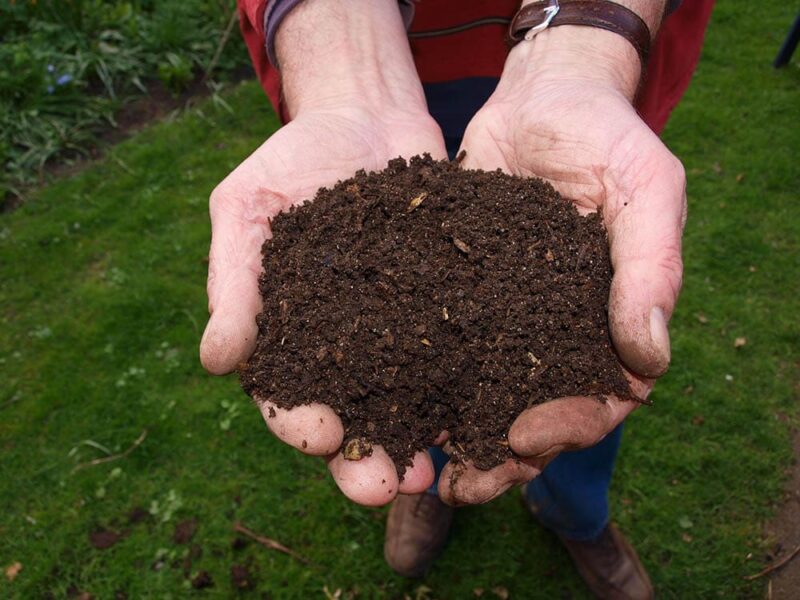
Compost will fill your raised bed with essential nutrients to ensure the most successful growth and abundant harvests. While it’s feeding your plants, compost still performs the standard mulch duties of slowing evaporation and insulating the soil.
You can prepare a compost heap with brown and green material blends collected during the day. If you feel like skipping the work, products like R&M Organics premium compost will supply the reliably rich fertilizer your plants crave.
Using Compost Mulch
The broken-up texture makes compost easy to work around plants in a raised bed. As a fine organic material, compost breaks down quickly, so you’ll have to replenish it more often throughout the season than some other sturdier mulches. It also doesn’t supply the weed control that other longer-lasting varieties offer.
- Supplies essential nutrients to improve plant growth
- Easy to work around plants
- Doesn’t last long and needs more frequent replenishing
- Not as effective at suppressing weeds as other mulches

Conclusion
Raised beds add a tidy look to the garden and a chance to take more control over the growing process. Mulch choice is essential, as is the proper upkeep once you land on your preferred bed cover. With these insights on picking the best mulch for your raised bed, you’ll have no problem seeing incredible returns on your hard work.
Featured Image Credit: Alison Hancock, Shutterstock
Contents

